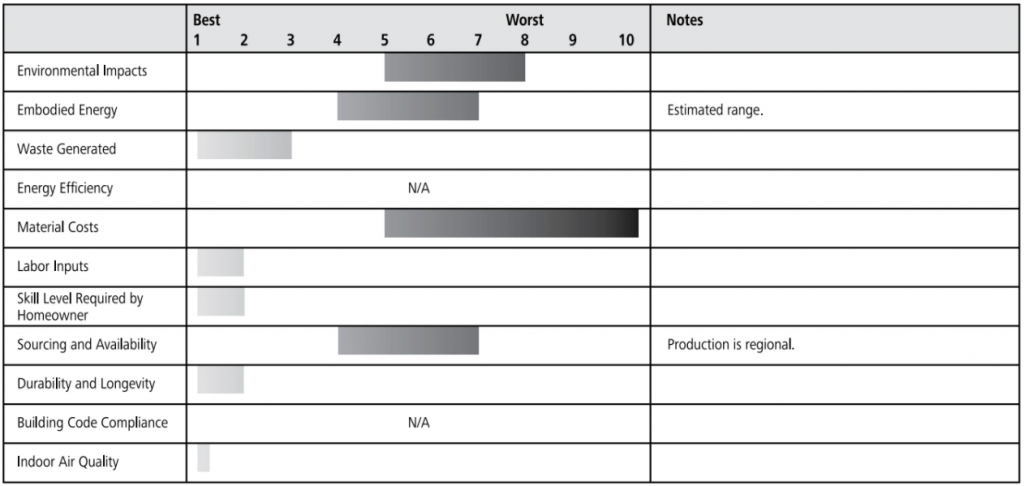Silicate Paint
Finishes: MATERIALS ENCYcLOPEDIA
Applications for this system
Interior and exterior mineral surfaces (clay, lime, cement, gypsum)
Not suitable for use on:
– Floors
– Wood
– Metal
Basic materials
Sodium silicate or potassium silicate
Water
Alkaline-resistant pigment
Ratings Chart for silicate paint

The ratings chart shows comparative performance in each criteria category. Click on the tabs below for detailed analysis of each criteria.
- HOW THE SYSTEM WORKS
- ENVIRONMENTAL IMPACTS
- WASTE
- MATERIAL COSTS
- LABOUR INPUT
- SKILL LEVEL REQUIRED
- SOURCING & AVAILABILITY
- DURABILITY
- INDOOR AIR QUALITY
- RESOURCES
- FUTURE DEVELOPMENT
Silicate paint System
Silicate paints are also known as water glass, silicate dispersion paint, silicate mineral paint or silicate emulsion paint.
Sodium and potassium silicate are water soluble, and when dispersed onto a mineral surface such as clay, lime or cement plaster will bind with silicates in the substrate, petrifying into a microcrystalline structure. These tiny pores are ideal for repelling liquid water but do not restrict the passage of vapor, giving this paint the ideal balance of moisture-handling properties. Exterior surfaces are protected against the entry of rain but allow migrating humidity to leave the wall. Interior surfaces are washable, so the paint can be used in kitchens and bathrooms.
Application of silicate paint is usually a two-step process, with a primer/binder going on as a first coat and the paint as a second and, if necessary, third coat.
Environmental Impact Rating
Harvesting — Moderate
Sodium silicate is made by combining silica and sodium hydroxide.
Industrial silica comes from quartz deposits. Quartz, the second most common mineral on the planet, is an abundant, non-renewable resource. Silica sand deposits are most commonly surface-mined in open-pit operations, but dredging and underground mining are also common methods of extraction. Impacts include habitat destruction and water contamination.
Sodium hydroxide (also known as lye), derived from sodium chloride (brine, or salt water), is a common compound used in everything from food to drain cleaner. Impacts are relatively low.
Manufacturing — Moderate to High
Quartz ore undergoes considerable processing to increase the silica content by reducing impurities. It is then dried and sized to produce the optimum particle size distribution for the intended application. Impacts include air and water pollution and greenhouse gas emissions.
The manufacture of sodium hydroxide from sodium chloride requires high energy input, with chlorine gas a by-product. Impacts include air and water pollution and greenhouse gas emissions.
Transportation — Low to High
Silicate paint is not widely manufactured, and is shipped as a heavy liquid. It may incur significant transportation impacts depending on distance traveled.
Installation — Negligible
Waste: Negligible
Compostable/Biodegradable — Silicate paint can be put in compost or on the ground.
Recyclable — Paint containers.
Material costs: high
These manufactured products are produced on a limited scale and tend to be priced higher than other commercially available paints.
Labour Input: low
Silicate paint is comparable to other paint types, and can be applied by brush and/or roller.
Skill level required for homeowners
Preparation of substrate — Easy
In most cases, a silicate primer coat is required.
Application of finish — Easy
Brushing or rolling.
Sourcing & availability: moderate
There are only a few manufacturers of silicate paints in North America, and their products are not typically available through paint stores or building supply outlets. Silicate paints can be ordered directly from the manufacturer or through specialty retailers.
Durability: High
Silicate paint mineralizes on the substrate, forming a chemical bond that is very different from film-type coatings. These paints become part of the substrate and do not flake or crack, providing a very long-lasting finish. Inorganic pigments resist fading due to UV exposure. Additional coats may be added directly over old paint.
Indoor air quality: high
Silicate paint will have no negative effect on IAQ. There are no toxins and no off-gassing from these paints. They are anti-bacterial due to their alkaline nature.
Resources for further research
n/a
Future development
Silicate paint is gaining a foothold in the market for the refurbishment of older concrete, brick and stone structures. As its popularity and availability increases, its benefits may be applied to new construction as well. These paints are widely recognized in the natural building world as an ideal coating for walls that have integral plaster skins with no rainscreen, as they provide a lot of protection from rain without restricting vapor permeability.
Tips for a successful silicate paint finish
1. Silicate paints are proprietary products. Follow the manufacturer’s instructions for successful application.
2. Silicate paint will reduce the carbonization that occurs in lime plasters. Avoid painting for at least thirty days after applying the plaster.



